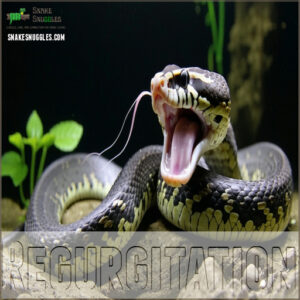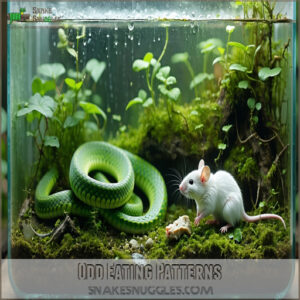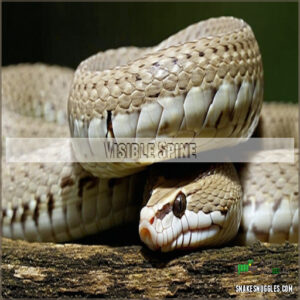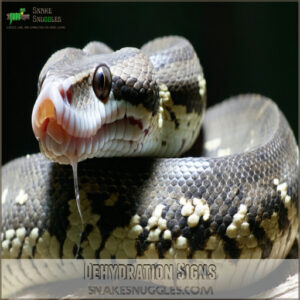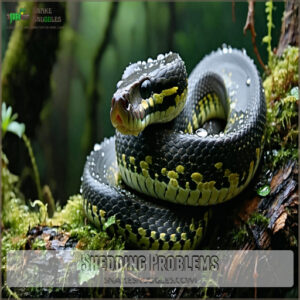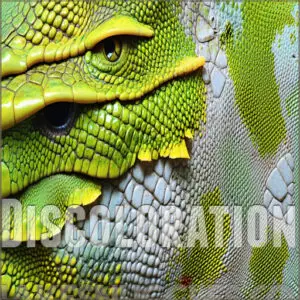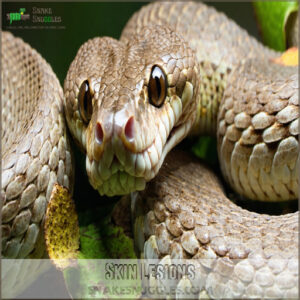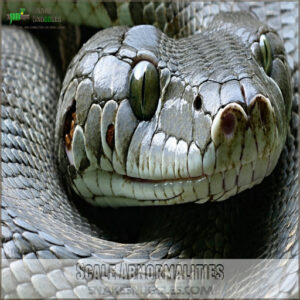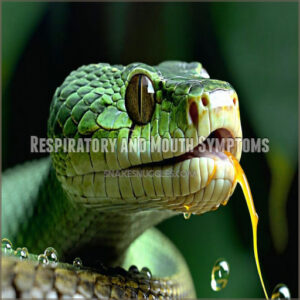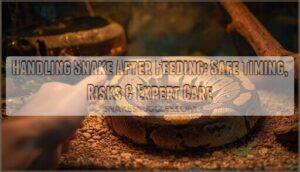This site is supported by our readers. We may earn a commission, at no cost to you, if you purchase through links.
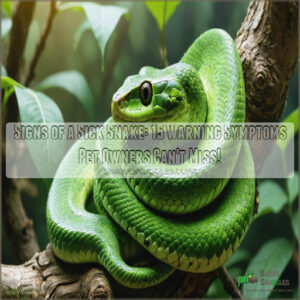
Watch for red flags like sudden lethargy, where your slithery friend becomes a couch potato, refusing to move or engage. If your snake’s hiding more than a spy and skipping meals, it’s time to worry. Unusual aggression, rigid postures, or dramatic weight loss can signal serious health issues.
Changes in behavior aren’t just mood swings—they’re your snake’s way of saying, "Something’s wrong!" Prolonged hiding, skipping favorite prey, or weird body positions are your cues to investigate.
Don’t wait until it’s too late; a quick vet check could save your scaly companion’s life.
Table Of Contents
- Key Takeaways
- Behavioral Changes
- Appetite and Weight Issues
- Physical Appearance Issues
- Respiratory and Mouth Symptoms
- Unusual Posturing and Movement
- Frequently Asked Questions (FAQs)
- How can you tell if a snake is bad?
- What are signs of discomfort in snakes?
- What happens when snakes get sick?
- How to tell if a snake has a respiratory infection?
- How often should a healthy snake poop?
- Can snakes catch diseases from their owners?
- What environmental factors stress pet snakes?
- How do I know my snakes enclosure needs cleaning?
- Are there genetic disorders common in pet snakes?
- Conclusion
Key Takeaways
- You’ll want to track sudden changes in your snake’s behavior, appetite, and energy levels – these aren’t just mood swings but critical health signals that could indicate serious underlying issues.
- Watch for physical warning signs like weight loss, unusual skin discoloration, scale abnormalities, and respiratory symptoms, which can quickly reveal your snake’s declining health and need for veterinary attention.
- Your snake’s body language speaks volumes: abnormal posturing, stargazing, stiffness, or limp stances aren’t just weird positions but potential indicators of neurological problems or severe health conditions.
- Don’t wait or guess – when you notice multiple symptoms like prolonged hiding, aggressive behavior, breathing difficulties, or dramatic appetite changes, it’s time to consult a reptile veterinarian immediately to prevent potentially life-threatening complications.
Behavioral Changes
If you’ve noticed your snake acting differently, it’s time to pay attention.
Sudden changes in behavior, from reduced activity to unusual aggression, can be critical warning signs that something’s wrong with your scaly companion.
Reduced Activity Levels
Noticing your snake’s energy loss? A sluggish snake or one showing lethargy signs might be a cause for concern.
Watch for:
- Activity decrease, like staying in one spot for days.
- Movement reduction during usual active hours.
- Sluggish behavior, ignoring its environment.
- Decreased appetite or refusal to eat, often accompanying inactivity.
Stress from improper handling can cause snake behavior problems.
These changes could signal illness or improper habitat conditions.
Prolonged Hiding
When your snake retreats from its usual spots for days on end, it’s time to tune into those hiding patterns.
Prolonged hiding isn’t just normal snake behavior—it could signal serious stress or illness.
Watch for environmental factors disrupting your snake’s habitat, as these might trigger unusual lethargy that goes beyond typical snake resting periods.
Loss of Appetite
When a snake suddenly goes from being a voracious eater to refusing meals, it’s time to pay attention.
Food refusal can signal serious health concerns beyond simple disinterest.
Whether it’s skipping a favorite prey or completely losing appetite, these eating problems might indicate underlying issues like stress, illness, or environmental changes that demand your immediate veterinary investigation.
Abnormal Aggression
When your usually calm serpent starts acting like a tiny, scaly angry monster, it’s time to pay attention. Stress and illness can trigger abnormal aggression in snakes, turning them from docile companions to defensive fighters.
Watch for these warning signs:
- Increased striking attempts without provocation
- Constant hissing and tight coiling
- Sudden shifts from calm to aggressive behavior
These stress signals might indicate something’s wrong under the surface.
Unusual Postures
Shifting from aggression to body language, your snake’s posture speaks volumes about its health. Weird angles, rigid stances, or a limp stance can signal serious trouble.
Watch for stargazing—an unnatural upward gaze—or abnormal coiling that deviates from your snake’s typical position. These twisted postures might be your first warning that something’s wrong under the surface.
Appetite and Weight Issues
Regarding your snake’s health, appetite and weight changes can be critical warning signs that something’s wrong.
You’ll want to pay close attention to sudden food refusals, unexpected weight loss, or unusual eating patterns that deviate from your snake’s normal behavior.
Weight Loss
After observing reduced activity, your snake’s weight decline might signal serious health concerns.
Muscle wasting and a prominent spine can indicate underlying issues.
When food refusal persists and body condition deteriorates, don’t ignore these warning signs.
Unexplained weight loss paired with lethargy demands immediate veterinary attention, as it could reveal critical dehydration or hidden medical problems.
Regurgitation
Over time, regurgitation signals serious digestive issues in your pet snake.
When a snake repeatedly vomits food, it’s more than a simple feeding problem—it’s a red flag for underlying health complications.
Potential causes range from improper handling and temperature stress to parasitic infections or serious gastrointestinal disorders.
Always consult a reptile veterinarian to diagnose and treat these concerning symptoms.
Odd Eating Patterns
A snake’s culinary capriciousness can signal serious health troubles.
When your serpent starts skipping meals or displays erratic eating habits, it’s time to pay attention.
Occasional food refusal might seem normal, but persistent changes in appetite could indicate underlying issues.
Watch for unexplained weight loss and shifts in typical feeding patterns that deviate from your snake’s usual routine.
Visible Spine
When weird eating patterns lead to alarming body changes, a visible spine might be your snake’s silent distress signal. Muscle wasting exposes vertebrae, revealing potential weight loss and serious health concerns.
Snakes typically exhibit active foraging behavior. If your snake’s spine looks more prominent than usual, it’s time to check for dehydration signs, lethargy, and overall body condition.
Prompt veterinary attention is key.
Physical Appearance Issues
Regarding your pet snake’s health, its physical appearance can tell you volumes about what’s going on beneath those scales.
You’ll want to become an expert at spotting subtle changes in your snake’s skin, scales, and overall body condition that could signal underlying health issues.
Dehydration Signs
When weight loss hits your snake’s health hard, dehydration might be the culprit.
Watch for telltale signs like sunken eyes, dry skin, and sticky saliva.
Pet owners can purchase snake hydration products.
Pinch a scale gently—if it doesn’t snap back quickly, your slithery friend needs hydration.
Lethargy and loss of appetite often accompany these symptoms, signaling it’s time for immediate care and rehydration.
Shedding Problems
Almost every snake owner dreads dysecdysis—those pesky shedding problems that can signal serious health concerns.
Improper shedding isn’t just cosmetic; it’s a red flag for underlying issues.
Watch for these critical signs of shedding troubles:
- Incomplete skin removal
- Patches of retained shed
- Torn or damaged scales
- Multiple fragmented shed pieces
Monitoring for early signs is essential to prevent potential complications and keep your scaly friend healthy.
Stay vigilant to prevent potential complications and keep your scaly friend healthy.
Discoloration
A serpent’s skin tells a story of health, and discoloration can be its first whispered warning. Your snake’s color changes aren’t just cosmetic—they’re health indicators that demand your attention. For an in-depth guide to reptile wellness, consult this informative snake health resource.
| Color Change | Potential Significance |
|---|---|
| Pink/Reddish | Possible Sepsis |
Skin Lesions
Skin lesions can quickly turn from minor irritations to serious health threats for your snake.
Watch for scab formation, blisters, or discolored scales that signal potential skin infections.
Consider researching effective snake skin lesion treatment options.
Different wounds require specific care—some might need veterinary attention, while others can be managed with proper husbandry.
Prompt recognition and treatment are your snake’s best defense against escalating health issues.
Scale Abnormalities
After spotting skin lesions, you’ll want to check your snake’s scales carefully.
Scale abnormalities can signal serious health issues. Watch for:
- Loose or damaged scales
- Discolored patches
- Signs of scale rot
Healthy scales should look smooth and uniform. Scale damage might indicate underlying infections, poor habitat conditions, or nutritional deficiencies. Don’t ignore even minor scale changes – they could be your snake’s cry for help.
Respiratory and Mouth Symptoms
If you’re worried about your snake’s respiratory health, it’s essential to know the warning signs that something might be wrong.
Keep an eye out for symptoms like mucus bubbles, wheezing, or open-mouthed breathing.
These could indicate a serious underlying condition that needs immediate veterinary attention.
Respiratory Infections
When scale concerns interrupt your snake’s health, respiratory infections become a serious warning sign.
Labored breathing, gurgling sounds, and open-mouthed gasping signal potential airway obstruction.
These respiratory problems can quickly escalate to snake pneumonia or respiratory failure.
Watch for common respiratory diseases like pneumonia. Watch for wheezing, nasal discharge, and unusual breathing patterns that might demand immediate veterinary nebulization therapy.
Mouth Rot
In spite of the best pet care, mouth rot can sneak up on your snake like a silent predator.
This serious mouth infection, known as infectious stomatitis, causes painful oral lesions and gum disease that can quickly worsen.
Effective snake mouth rot treatment is important for recovery.
Watch for swollen jaws, cheesy pus accumulations, and tooth abscesses—telltale signs your scaly friend needs immediate veterinary attention.
Mucus Bubbles
When mucus bubbles appear around your snake’s mouth or nostrils, it’s time to pay attention. These tiny, troublesome signals often indicate serious respiratory issues or potential mouth rot.
Stringy saliva and visible bubble formations are red flags of underlying respiratory disease that demand immediate veterinary intervention. Don’t wait—early detection can save your slithery friend’s life.
Wheezing
When mucus bubbles hint at deeper troubles, wheezing becomes your snake’s distress signal. Listen closely for unusual respiratory sounds like whistling or crackling – they’re red flags for potential airway obstruction.
Gasping or labored breathing means your reptilian friend is struggling. These wheezing symptoms could indicate serious respiratory problems demanding immediate veterinary attention.
Open-Mouthed Breathing
When your snake breathes with an open mouth, it’s signaling respiratory distress that needs immediate attention.
Unlike wheezing, open-mouthed breathing often indicates severe airway obstruction or breathing issues that could lead to life-threatening complications.
You’ll notice your snake keeping its mouth consistently open, often accompanied by labored breathing and gasping sounds.
Don’t wait to seek veterinary care – this symptom requires swift action.
Unusual Posturing and Movement
You’ll notice your snake isn’t feeling well when it starts moving differently or holding unusual positions, like staring at the ceiling or lying completely limp.
While snakes naturally twist and coil, watch for signs that your pet can’t moving normally or maintain proper body control, as these changes often signal serious health issues that need a vet’s attention.
Abnormal Coiling
While respiratory issues cause noticeable breathing changes, your pet’s body positioning can tell an equally important story.
Watch for abnormal coiling patterns that differ from your snake’s usual resting positions. If you notice twisted body positions or odd postures where they’re unable to maintain normal circular coils, it’s time for concern.
Healthy snakes display smooth, natural curves – anything else might signal underlying health problems.
Stiffness
While abnormal coiling might catch your eye first, muscle rigidity deserves equal attention. Stiffness signs in your serpentine friend often point to underlying health concerns that need quick action. Joint pain and spinal issues can make your pet move like they’re wearing an invisible cast.
- Rigid postures lasting more than a few hours suggest neurological problems
- Look for difficulty bending or straightening their body
- Watch for resistance when trying to uncoil
- Notice if they maintain twisted positions unusually long
Stiffness signs can indicate serious health concerns, so it’s crucial to monitor your pet’s behavior closely. If you notice any of these symptoms, seek veterinary attention promptly to address potential joint pain or other underlying issues.
Limp Stance
While stiffness signals certain health concerns, a limp stance represents a different warning sign entirely.
Your snake’s weak muscles and inability to maintain normal body positions could indicate serious neurological issues or spinal injury.
Watch for a limp body that seems to flop or sag unnaturally – this muscle atrophy isn’t normal sluggishness.
If you notice odd body postures or complete limpness, contact your vet immediately.
Stargazing
Often, an unsettling neurological sign called stargazing can signal serious health troubles in your snake.
This peculiar behavior involves your snake staring upwards in an unnatural position, potentially indicating severe underlying conditions like Inclusion Body Disease (IBD).
Understanding corn snake body language can help differentiate normal behavior from illness.
Critical indicators include:
- Persistent upward head orientation
- Inability to right body position
- Head tilting at odd angles
- Unresponsiveness to environmental stimuli
- Disrupted normal movement patterns
Twisted Positions
If stargazing wasn’t unsettling enough, neck twisting takes snake body language to a whole new level of weird.
When your snake starts contorting into odd postures or resting at unnatural angles, it’s your cue to pay attention.
Spinal issues or neurological problems might be lurking, turning your pet’s body into a twisted roadmap of potential health concerns.
Frequently Asked Questions (FAQs)
How can you tell if a snake is bad?
Whoa, Nelly! If your snake’s acting like a zombie – hiding constantly, losing weight, or looking sickly – it’s time to call the vet.
Watch for changes in behavior, appetite, and physical appearance that scream **something’s wrong
What are signs of discomfort in snakes?
You’ll notice snake discomfort through unusual hiding, sudden aggression, changes in movement patterns, and altered body postures.
Watch for signs like lethargy, unusual skin coloration, and reluctance to be handled.
These might indicate underlying health concerns.
What happens when snakes get sick?
80% of snake health issues are linked to poor husbandry.
You’ll see your pet’s health decline through dramatic changes: lethargy, appetite loss, abnormal shedding, respiratory distress, and unusual behavior signaling underlying medical problems.
How to tell if a snake has a respiratory infection?
When your slithery friend struggles to breathe, watch for open-mouth gasping, wheezing sounds, and mucus bubbles.
Unusual respiratory noises, nasal discharge, and labored breathing scream potential respiratory infection—time to call the vet.
How often should a healthy snake poop?
Ever wondered about your snake’s bathroom schedule?
Healthy snakes typically poop every 4-6 weeks, depending on their species, diet, and metabolism.
Frequency varies, so don’t panic if your scaly friend’s routine seems slightly different.
Can snakes catch diseases from their owners?
You can indeed catch and pass diseases to your pet snake through direct contact, especially with poor hygiene.
Zoonotic diseases like salmonella are potential risks, so always wash your hands before and after handling your reptilian friend.
What environmental factors stress pet snakes?
When a snake’s world feels like a rollercoaster, stress creeps in.
Temperature fluctuations, improper humidity, loud noises, frequent handling, and inadequate hiding spots can turn your reptilian friend’s habitat into a nerve-wracking nightmare.
How do I know my snakes enclosure needs cleaning?
You’ll know it’s time to clean your snake’s enclosure when you spot accumulated waste, shed skin, uneaten food, or a musty odor.
Regular spot cleaning and deep cleaning every few weeks keep your reptile’s home healthy.
Are there genetic disorders common in pet snakes?
Like a hidden serpent’s curse, genetic disorders lurk in your pet snake’s lineage.
Inbreeding, mutations, and rare conditions can impact your scaly companion’s health.
Work closely with specialized reptile veterinarians for early detection and management.
Conclusion
Remember when your buddy’s cat caught a mysterious illness? Just like that, snakes whisper their health struggles through subtle signs. By staying vigilant about the signs of a sick snake, you’re not just a pet owner—you’re a lifeline.
Don’t ignore the warning symptoms. Trust your instincts, consult professionals promptly, and prioritize your snake’s well-being.
Regular health checks and keen observation can transform potential health crises into manageable challenges, ensuring your scaly companion thrives.
- https://www.petmd.com/reptile/care/evr_rp_how-can-i-tell-if-my-snake-sick
- https://mysnakepet.com/signs-of-a-sick-snake/
- https://vcahospitals.com/know-your-pet/snakes-diseases
- https://pattonvethospital.com/blog/1151870-three-common-illnesses-of-pet-snakes
- https://www.redwoodpetclinic.com/2019/09/15/marin-county-ca-vet-signs-of-illness-snakes/



